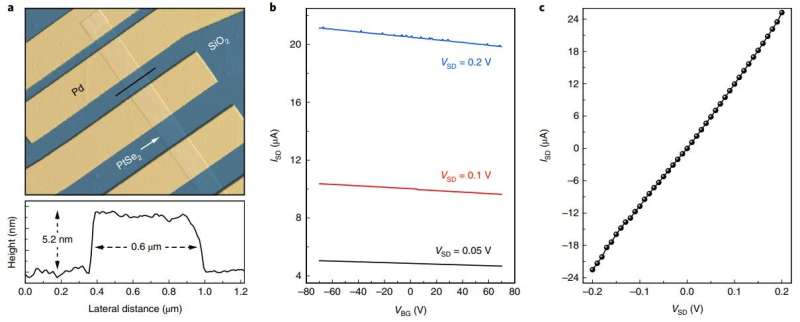A new 2-D magnet draws future devices closer

We are all familiar with the image of electrons zipping around an atom's nucleus and forming chemical bonds in molecules and materials. But what is less known is that electrons have an additional unique property: spin. It is difficult to make an analogy, but one could crudely describe electron spin as a spinning-top rotating around its axis. But what is even more interesting is that when spins of electrons align together in a material this leads to the well-known phenomenon of magnetism.
One of the most cutting-edge fields in technology is spintronics, a still-experimental effort to design and build devices—such as computers and memories—that run on electron spin rather than just the movement of charges (which we know as electrical current). But such applications demand new magnetic materials with new properties. For example, it would be a huge advantage if magnetism occurs in an extremely thin layer of material—the so-called two-dimensional (2-D) materials that include graphene, which is basically an atom-thick layer of graphite.
However, finding 2-D magnetic materials is challenging. Chromium iodide (CrI3) recently revealed many interesting properties, but it degrades rapidly in ambient conditions and its insulating nature doesn't promise much in the way of spintronics applications, most of which require metallic and air-stable magnetic materials.
Now, the groups of Andras Kis and Oleg Yazyev at EPFL have found a new metallic and air-stable 2-D magnet: platinum diselenide (PtSe2). The discovery was made by Ahmet Avsar, a postdoc in Kis's lab, who was actually looking into something else entirely.
To explain the discovery of magnetism in PtSe2, the researchers first used calculations based on density functional theory, a method that models and studies the structure of complex systems with many electrons, such as materials and nanostructures. The theoretical analysis showed that the magnetism of PtSe2 is caused by the so-called "defects" on its surface, which are irregularities in the arrangement of atoms. "More than a decade ago, we found a somewhat similar scenario for defects in graphene, but PtSe2 was a total surprise for us," says Oleg Yazyev.
The researchers confirmed the presence of magnetism in the material with a powerful magneto-resistance measurement technique. The magnetism was surprising, since perfectly crystalline PtSe2 is supposed to be non-magnetic. "This is the first time that defect-induced magnetism in this type of 2-D materials is observed," says Andras Kis. "It expands the range of 2-D ferromagnets into materials that would otherwise be overlooked by massive database-mining techniques."
Removing or adding one layer of PtSe2 is enough to change the way spins talk to each other across layers. And what makes it even more promising is the fact that its magnetism, even within the same layer, can be further manipulated by strategically placing defects across its surface—a process known as "defect engineering" that can be accomplished by irradiating the material's surface with electron or proton beams.
"Such ultra-thin metallic magnets could be integrated into the next generation spin-transfer torque magnetic random-access memory (STT MRAM) devices", says Ahmet Avsar. "2-D magnets could reduce the critical current required to change magnetic polarity, and help us with further miniaturization. These are the major challenges that companies are hoping to solve."
More information: Ahmet Avsar, Alberto Ciarrocchi, Michele Pizzochero, Dmitrii Unuchek, Oleg V. Yazyev, Andras Kis. Defect induced, layer-modulated magnetism in ultrathin metallic PtSe2. Nature Nanotechnology 17 June 2019. DOI: 10.1038/s41565-019-0467-1 , www.nature.com/articles/s41565-019-0467-1
Journal information: Nature Nanotechnology
Provided by Ecole Polytechnique Federale de Lausanne





















